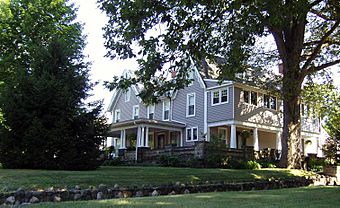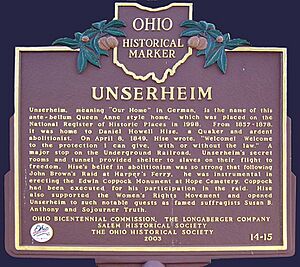Daniel Howell Hise House facts for kids
Quick facts for kids |
|
|
Daniel Howell Hise House
|
|

Daniel Howell Hise House, Salem, Ohio
|
|
| Location | 1100 Franklin Avenue Salem, Ohio |
|---|---|
| Built | 1838 |
| Architect | Daniel Howell Hise, Ben Hilman, and George Fleck |
| Architectural style | Gothic Revival (exterior) |
| NRHP reference No. | 99000319 |
| Added to NRHP | March 25, 1999 |
The Daniel Howell Hise House is an old and important home in Salem, Ohio. It played a special role in history as part of the Underground Railroad. This house is officially listed on the National Register of Historic Places.
Contents
Why This House Is Important
The Daniel Howell Hise House is listed on the National Register of Historic Places. This means it is a very important historical site. It is recognized for its role in social history. It also has importance for African-American history. The house is also famous because of its owner, Daniel Howell Hise.
History of the Hise House
The house was built in the early 1850s. Daniel Hise's father built it. Daniel Hise and his wife Margaret moved in around 1875. They gave the house a new name, Unserheim. This means "our home" in German. They also made some changes to the house.
The Underground Railroad Connection
Daniel and Margaret added secret hiding spots to the house. These included hidden rooms in the basement. There was also a barn on the property with secret areas. These changes made the house a safe stop. It became a part of the Underground Railroad. The Underground Railroad was a secret network. It helped enslaved people escape to freedom.
Daniel Hise was a strong supporter of ending slavery. He was inspired by Amos Gilbert. Hise was part of the Executive Committee. This was for the Western Anti-slavery Society. He also helped organize the Anti-Slavery Fair in Salem. This fair raised money for the cause.
Hise believed in the ideas of William Lloyd Garrison. Garrison was a famous abolitionist. From 1849 to 1855, Hise opened his home. It was a safe place for people escaping slavery. It also hosted other abolitionists. These included Oliver Johnson and Parker Pillsbury.
Who Was Daniel Howell Hise?
Daniel Howell Hise was born in New Jersey. His birthday was September 12, 1813. His family moved to Salem in 1819. When he was young, he worked as an engineer. He worked on steamboats in Alabama during the summers. Later, he worked in Salem. He was a blacksmith and made tools. He also worked in roofing and kiln operations.
Hise did not see himself as a leader. But he was a very strong supporter of important causes. He worked to end slavery. He also supported women's right to vote. And he supported the temperance movement. This movement worked to reduce alcohol use.
Hise's Diary
Daniel Hise kept a detailed diary. He wrote in it from 1846 until his death. He passed away on November 17, 1878. His daughter, Nora, asked for it to be published. A local company published it in 1933. His diary gives us a look into Salem's history. It also shows its important role in the Underground Railroad.
The Hise House in Art
The famous American artist Charles E. Burchfield painted the Hise House. He created this painting when he lived in Salem.
Current Status of the House
The Daniel Howell Hise House is a private home today. It is not open for public visits.




